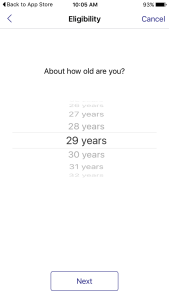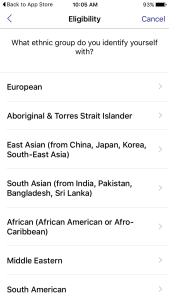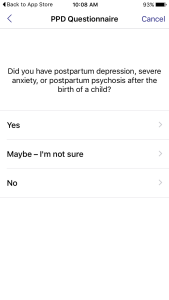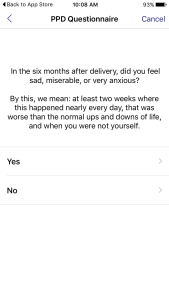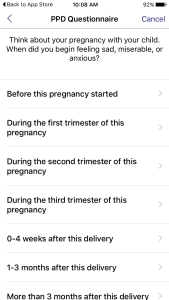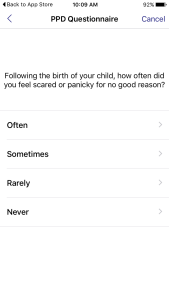Researchers from the University of Queensland have partnered with fellow academics from the University of North Carolina in the United States and Cardiff University in the United Kingdom to develop a smartphone app to survey women about postpartum depression (PPD, also knows as postnatal depression).
The app, which is only available for Apple devices at this point in time, asks mothers a series of questions about their lives, thoughts, actions and emotions following the birth of their children. The information will then used by researchers to map out PPD in the hope of learning more about the condition and how it can be treated.
Nursing Review spoke to Professor Naomi Wray from UQ's Queensland Brain Institute, and collaborator Jeannette Milgrom, professor of Psychology at University of Melbourne and the director of Parent-Infant Research Institute to find out more.
Why is it important to study PPD?
Jeannette Milgrom: One in five women will experience postpartum depression and accompanying feelings of hopelessness and despair at a time generally expected to be joyous. In Australia, just over 300,000 women give birth per year, so over 60,000 families are affected. PPD can cause disturbances in the mother-child relationship, which are associated with poor long-term cognitive and behavioural outcomes for the child. In addition, partner relationships are often affected. Depression is projected to impose the highest burden of any disease in Australia and worldwide by 2030. We don’t understand the causes of depression, including PDD, we hope our new study will ultimately lead to improved prevention, diagnosis and treatment.
Why is an app an effective tool for such a study?
Naomi Wray: Our overall aim is to recruit a large cohort of women who have ever experienced PPD. The app is a cost-effective way to reach a very large number of people. Women who have completed the survey may be invited to provide a spit sample from which we can measure differences in DNA between those women that get PPD and those that don’t. The goal of the international study is for 50,000 women who have had PPD to provide a DNA sample. In Australia, we are currently trying to secure funding to complete this part of the study.
JM: The app can also be used by those currently in the postpartum period to generate a self-assessment. Current screening practices, that are often based on paper and pencil tests and only detect a minority of cases, are inconsistently applied and prone to error. Australian Practice Guidelines for Perinatal Depression recommends screening as a useful way of identifying those women who may be depressed. The majority of women do not seek help. An accessible app has the potential to deliver consistent and accurate identification of women. Using the latest technology to promote and advance the best-practice has the potential to massively improve current practices. Current evidence suggests that electronic screening systems can have a positive impact on uptake.
Have you used apps to conduct studies before? If so, what was that experience like? Any interesting learnings?
JM: This is our first experience with a phone app. We have previously used online questionnaires to collect data for research, and indeed we hope that app users will be willing to complete a more detailed online questionnaire about depression over their lifetime. We also have experience in delivering internet-based treatment for postnatal depression and our trials reveal that women value this medium and adhere to treatment.
How are you promoting the app and the study so that people know about it and can participate?
NW: The app will be promoted widely including through the use of social media as well as via health professionals. Women who download the app will be asked about their postpartum experience. Importantly, we are keen to recruit women who have experienced PPD at any time, even it is 50 years ago, since our aim is to study the DNA of those who have experience PPD compared to those that have not. They will be asked questions about mood and anxiety symptoms in the postpartum period over the course of their lifetime. It will also ask about other emotional health problems in the postpartum period. Women will be given feedback to their responses to the questions and may be invited to provide more detailed information about their experiences with depression over their lifetime.
Here are some screenshots from the app, demonstrating some of its qualification and diagnostic questions:
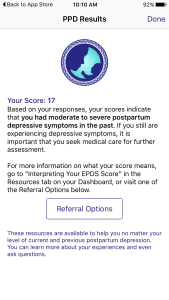
At the survey's close, participants are advised of their PPD status, based on their response, and there are referral options for more information.
Being a professor of psychology, Milgrom had an interesting, holistic view on the potential causes of PPD, which is directly linked to the motivation behind this research. "A complex interplay between psychological, social and biological factors contribute to postnatal depression," she said. "There remains a need to increase efforts at understanding the biological basis of PPD and related disorders and large population studies are needed as part of a strategy to identify more effective treatments."
In a similar vein, Wray from the QBI will be utilising her experience in physiology to advance our understanding of PPD. She also laid out the survey's ambitious respondent goal.
"Genetic studies have made important advances in our understanding of many other common diseases and disorders in the last 5 years," Wray said.
"All the indications are that similar advances can be achieved for PPD, but to do this we need DNA on 50,000 women who have experienced PPD. This is why the international research community has joined forces to launch the same app in many countries.
"The effort of participation is small for each woman, but that small effort is needed to accumulate sufficient numbers to generate new advances in prevention, diagnosis and treatment of PPD."
Do you have an idea for a story?Email [email protected]
 Aged Care Insite Australia's number one aged care news source
Aged Care Insite Australia's number one aged care news source

